A whirlwind of butterflies, bioluminescent night swimming, skewered chicken hearts and breakfast with Arnold Schwarzenegger – Dan Linstead and family’s South American odyssey is full of surprises
It’s a strange experience, being bombarded by butterflies. As we ambled along the boardwalks at Iguaçu Falls, the roar of whitewater in our ears, the flutterings increased. A flurry of turquoise here, a whirl of amber there, until they were all around us. Our 11-year-old, Barnaby, gathered eight into his cupped palms, and looked up with a smile I’d never seen before: ‘OMG’.We almost forgot the world wonder thundering away beside us.
Perhaps we were getting used to Brazil’s casual displays of affection. Since we’d arrived a fortnight earlier, this vast, abundant, complicated country – in the limelight as never before, courtesy of the Rio Olympic Games – had been throwing delights at us like confetti at Carnival.
Initially, though, it hadn’t seemed an obvious choice for a family holiday. The pre-trip headlines were full of the Zika virus and anti-government protests and the dubious water quality in Rio’s Guanabara Bay. And at the best of times, Brazil conjures up contrasting images: rainforest and samba, yes, but also favelas and crime.
But with the Olympics looming, Barnaby studying Brazil at school, and the desperate need for some sun, we decided to err on the side of adventure. Brazil is the size of Europe, so in a couple of weeks we were only ever going to be able to nibble a corner of it.
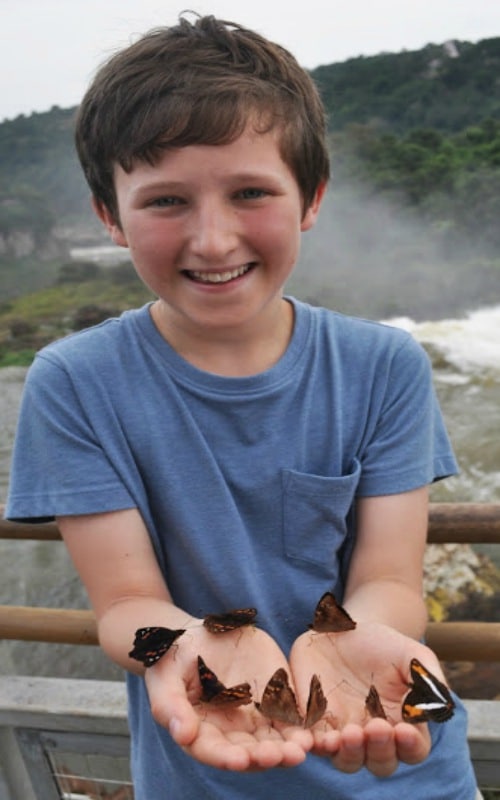
Colorful butterflies flock to visitors
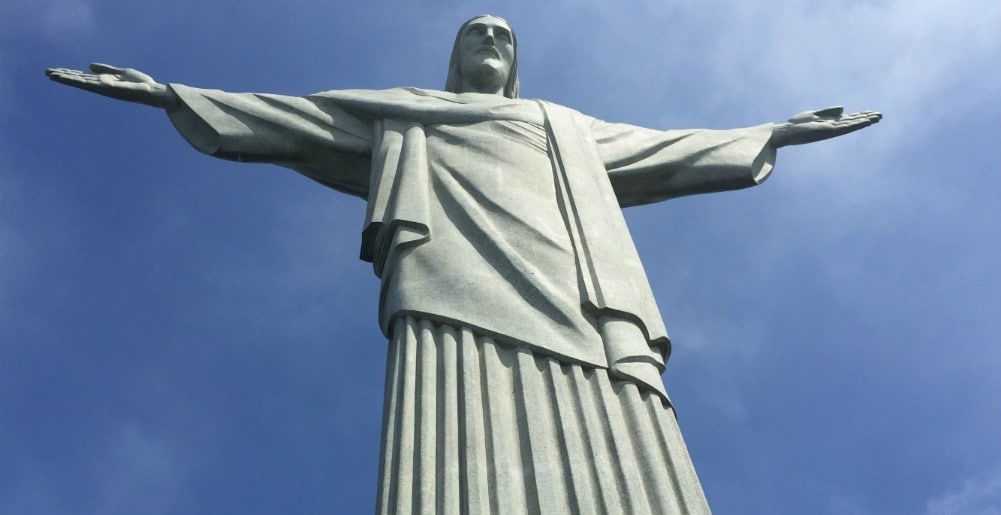
Christ the Redeemer towers above Rio
My wife Louisa and I plotted a route through the south of the country, and with Barnaby and his sister, Suki, eight, we flew to Rio. First impressions: the humidity and the flesh. We arrived in the evening, and as we nosed through the hothouse streets from the airport to Copacabana there were barely clad joggers everywhere, all miraculously unperspiring in 31C heat. At the beach, the foot- volleyball games were in full flow, the juice bars bustling. ‘We’re in Rio de Janeiro!’ marvelled Barnaby – and was instantly on Instagram.
We had planned a soft landing and booked into the Copacabana Palace, a 1920s grande dame, with the biggest pool in town and a stellar guestlist, ranging from Bing Crosby to – at the table beside us the next morning, somewhat puffy-eyed – Arnold Schwarzenegger. A splurge it may have been, but the hotel gave us two essentials for families exploring a hot city: magnificent breakfasts (pain au chocolat, melon and pancakes was Suki’s ultimate menu) and that swimming pool to retreat to in the sweltering afternoons. So what did we want to do first? There was only one answer: ‘Christ!’
So, we made our way to Rio’s iconic statue, a minibus ride up through the tangly Tijuca Forest which backdrops the city. From Christ’s feet, the hazy, mountainous jumble of the city started to make sense – we traced our taxi ride from the airport, along the bay, past Sugarloaf Mountain and onto the sweeping ocean beaches of Copacabana and Ipanema.
Vultures wheeled overhead as we jostled with the good-natured tourist hordes for the inevitable selfie: arms outstretched over Rio. Back in the bus, we passed a slither of ramshackle housing heading up into the hills: the Favela Santa Marta. Rio’s shantytowns have become almost as well-known as its statuary, and we had wondered about visiting one.
Santa Marta, it transpired, was one of three officially ‘pacified’ favelas, and for the past seven years has been free of the drug gangs which still preside over other parts of the city. A walking tour was available, with proceeds going to the community – which is how we came to be in a suburban garage forecourt the next morning, meeting Dylan.
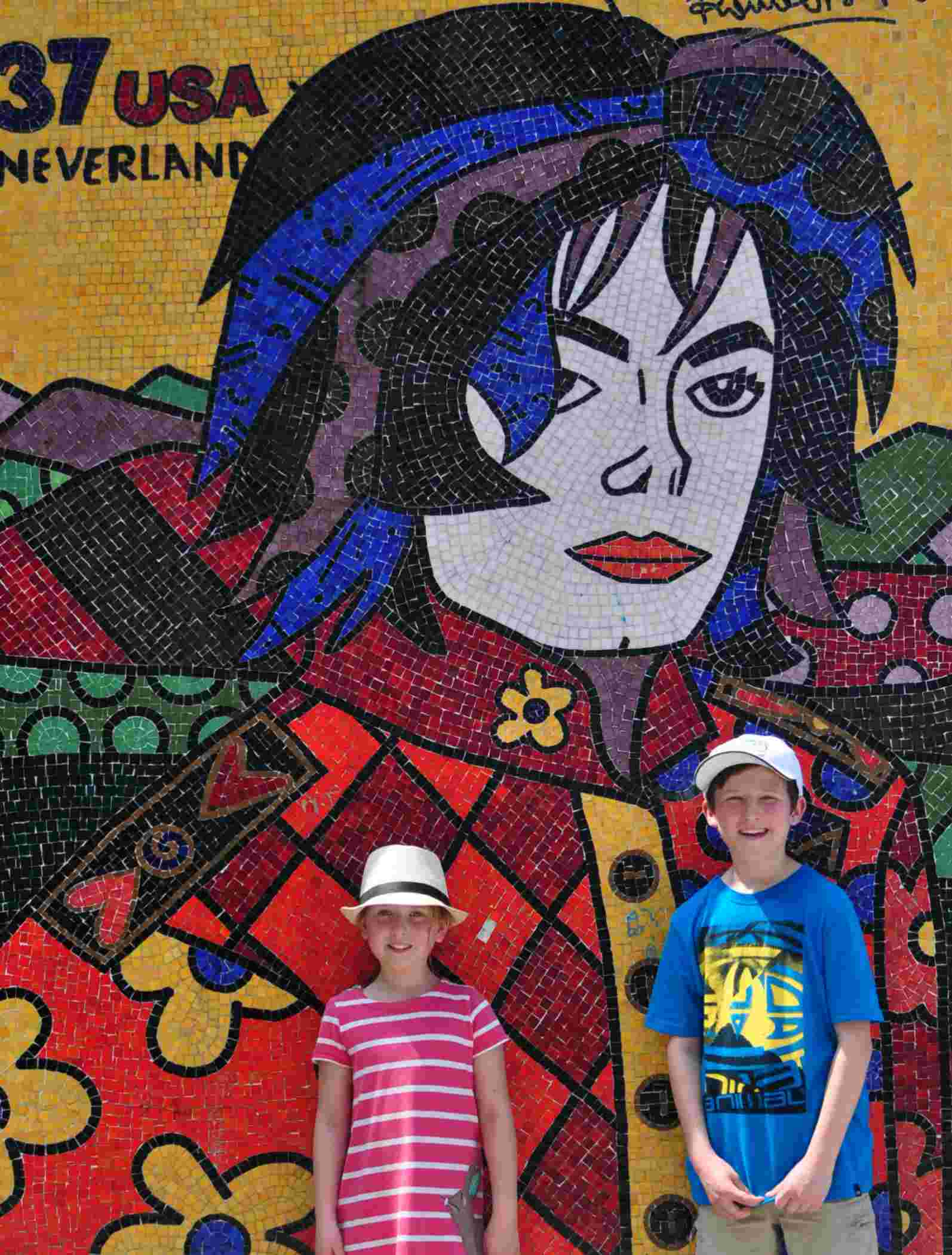
Michael Jackson street art in Rio
Dylan was a lean, bouncy kid with a dazzling smile, who spoke four languages at phenomenal speed. He was 21, and had lived all his life in the favela. ‘I used to go to school and keep quiet about what I’d seen,’ he said, when we asked him about what he called the ‘blood age’ before pacification. Now, he ran tours of his neighbourhood. ‘This is one of over 1,000 favelas in Rio,’ Dylan explained as we walked. ‘Right now, only three have tourism. We’ve got 90 security cameras, free wifi, and an elected president.’
The sunshine splashed over the mudbrick houses; families smiled out of windows at us. It all felt utterly safe. In fact, it seemed Santa Marta was a bit of a celebrity favela. Dylan pointed out where Michael Jackson had shot a music video, They Don’t Care About Us. ‘You know Fast & Furious 5 and Hulk? They filmed here, too. It’s like Favela-wood!’ But as our tour wound up, Dylan offered a sobering thought. ‘This could all end after the Olympics. Once the world isn’t looking, will the government still care?’
As we headed back to the cocoon of the Copacabana Palace – a true world away – we crossed our fingers for Santa Marta’s future.
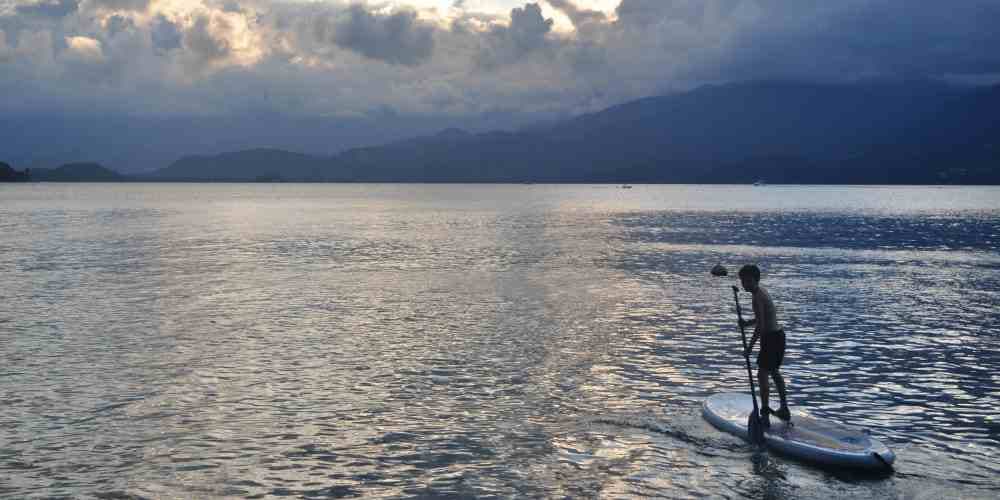
Scenic views and calm waters in Casa Cairucu make for the ultimate paddleboarding experience
Following a tip in the visitors’ book, we tiptoed down to the jetty after dark, jumped into the inky waters – and found our fingers and toes trailing phosphorescence. ‘It’s like the stars have fallen into the sea,’ marvelled Barnaby, displaying a rare poetic turn of phrase to describe the natural wonder of bioluminescence.
All too soon, though, our bags were back on the speedboat and we were headed back to the mainland. Next stop: Fazenda Catuçaba, a former coffee estate in the lush highlands behind Paraty, now a boho-luxe eco-retreat. We’d come here partly to break the journey to São Paulo, but also to get a flavour of the countryside. With its eucalyptus-and-pine-scented hills, cowhide rugs and stable of beautiful mangalarga horses,the fazenda had more than a touch of the Argentinian estancia about it.Meanwhile, there was more – so much more – of Rio to explore.
We marvelled at the trees and turtles in the Botanical Gardens. We ate steak and empanadas in the leafy streets of Leblon, and watched the sunset from Ipanema beach. We even managed a museum, the brand-new and brilliantly interactive Museum of Tomorrow, which – said Suki, gratifyingly – ‘really makes you think’. But our time in Rio was soon up, and we headed south-west, for quieter shores.
A few hours’ drive along the Costa Verde lay the little town of Paraty, a colonial haunt where we hoped to wind down from the pace of the city. The giant cobbles that line its streets date back to its 17th-century heyday as a gold port, and we passed a pleasant afternoon peering into whitewashed churches and watching hummingbirds flitting from one courtyard garden to another.
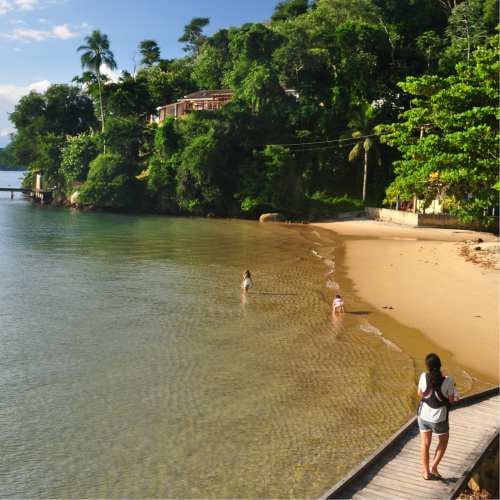
But pretty as Paraty is, the real lure for kids lies offshore, where hundreds of idyllic beaches hide among forested islands and headlands. Most visitors explore the area on a day trip by schooner, but there are also a handful of places to stay overnight, and we headed – on a spray-lashed, child-whooping speedboat – for one of the best: Casa Cairuçu. Owned by an Anglo-Brazilian couple, the house is an elegant bungalow tucked into the trees on the Ponta Grossa peninsula.
Approaching from the sea, all we could spy was a jetty, a cluster of paddleboards and a hint of hammock. There was no road access, electricity came from a generator, and catering (including skewered chicken hearts, our bloodthirsty children’s favourite) was courtesy of Adriana, wife of a local fisherman. Our days at Casa Cairuçu passed in a slow-motion haze of lounging and splashing.
Barnaby swiftly mastered stand-up paddleboarding, while Suki and Louisa kayaked from one white-sand beachlet to the next. We hired a boat and snorkelled off little Isla Comprida, where the kids squealed as they leapt into dense shoals of zebrafish. And we lay in hammocks on the veranda, eating too many of Adriana’s brigadeiros truffles, and watching frigatebirds and parakeets and the colourful parade of boats across the bay. The highlight, though, was a night-time dip on our final evening.
Following a tip in the visitors’ book, we tiptoed down to the jetty after dark, jumped into the inky waters – and found our fingers and toes trailing phosphorescence. ‘It’s like the stars have fallen into the sea,’ marvelled Barnaby,displaying a rare poetic turn of phrase to describe the natural wonder of bioluminescence.
All too soon, though, our bags were back on the speedboat and we were headed back to the mainland. Next stop: Fazenda Catuçaba, a former coffee estate in the lush highlands behind Paraty, now a boho-luxe eco-retreat.
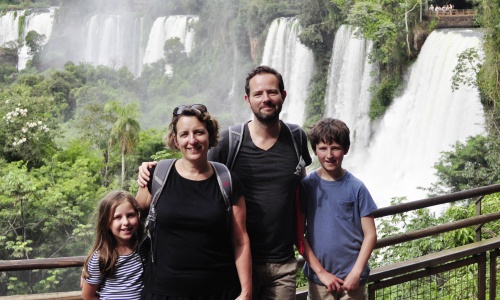
Family excursions to Iguacu rainforest waterfalls
Bellies full and slightly saddle sore, we then embarked on the last leg of the trip: a short flightfrom nearby São Paulo to a patch of rainforest on the Argentinian border with one almighty draw: Iguaçu Falls. Ranking the world’s greatest waterfalls is a tricky business (and would make a good Top Trumps deck, we decided), but the 1.7-mile-wide, 275-cascade torrent of water that froths the Rio Iguaçu is definitely top-five material.
We’d come here partly to break the journey to São Paulo, but also to get a flavour of the countryside. With its eucalyptus-and-pine-scented hills, cowhide rugs and stable of beautiful mangalarga horses,the fazenda had more than a touch of the Argentinian estancia about it. And we duly spent a couple of days having a kind of farmstay minibreak, surrounded by geese and chickens, serenaded by frogs, and shadowed at every step by a pair of soppy retrievers. The food here – brought to our lakeside cottage by VW camper, and served safari-style, al fresco – was sensational: allotment aubergines, local acai jam,homemade fennel bread, and a stash of fudge and biscuits which drew the wide-eyed query from Suki: ‘Are we really allowed to eat that?
Driving through the surrounding national park, we heard it before we saw it – a rumble rising to a roar, and then we were in an ampitheatre of whitewater, the torrent of the main river offset by hundreds of smaller cataracts in the jungle all around us. There was only one word for it: awesome.
We were staying at the Belmond Hotel das Cataratas, the only hotel in the national park, with views of the falls from the terrace bar. And the location wasn’t just scenic; it also gave us effectively private access to the falls when the park gates were locked to daytrippers. For a couple of hours in the mornings, we lucky guests
could walk the gangways in virtual solitude: a delicious experience, like being handed the keys to the Grand Canyon. The kids were initially wowed by the sheer scale of the falls, but it was the wildlife that held their interest.
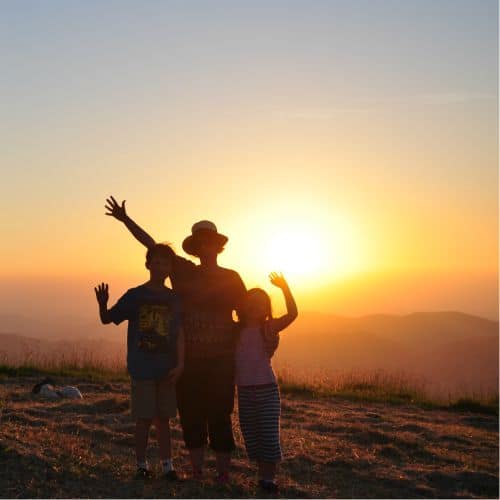
Sunset at Fazenda Catucaba
Iguaçu’s rainforest brims with creatures, and many of them seemed far from shy. Capuchin monkeys larked about in the hotel gardens, raccoon-like coatis snuffled along the trails, and we even saw a sleepy rattlesnake (photo opportunity!) being carefully monitored by a park warden. And then there were the butterflies: little scraps of red, yellow and blue everywhere we went, but thickest when we crossed the border to explore the Argentinian side of the falls.
As they settled in our hands, and Barnaby and Suki giggled with amazement, the world seemed to shrink a little. We’d come on a big trip to see big things – Christ the Redeemer, Copacabana beach, Iguaçu Falls – but when we sat down that night to reminisce about our Brazilian adventure, it was the small stuff that lingered: a kid in a favela, a swim in a glowing sea, and the day we were bewitched by butterflies.
How to get there: British Airways flies direct from Heathrow to Rio daily from £649 return. The flight is 11-and-a-half hours, but with only a three-to four-hour time difference and lots of onboard entertainment, it’s very manageable with children. No jabs are required for Rio, but yellow fever is recommended for the Iguaçu area.
Getting around: Latin America expert Last Frontiers organises tailor-made trips to Brazil: a fortnight’s trip including Rio, Paraty, Catuçaba and Iguaçu, internal transfers and flights (internationally into Rio and out of São Paolo, plus the internal flight Rio to Iguaçu) costs from £2,940pp based on four people travelling together, staying in two rooms, on a B&B basis. Last Frontiers is a specialist in tailor-made trips and has suggested itineraries for Brazil on its website.
Where to stay: The Belmond Copacabana Palace in Rio and das Cataratas at Iguaçu offer old-world luxury, fine dining and superb concierge services. Price from £500 per room and £340 per room. belmond.com Casa Cairuçu is a boat-access-only villa on the forested shores of Paraty Bay. Perfect for six to eight people; from £275 per night for the whole house, including boat trips and transfers.